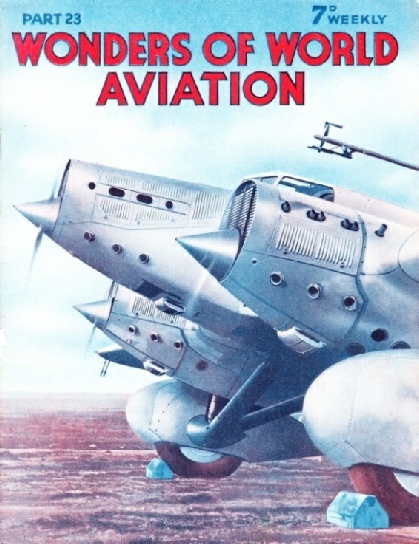
© Wonders of World Aviation 2015-


Part 23
Part 23 of Wonders of World Aviation was published on Tuesday 9th August 1938, price 7d.
This part included a colour plate showing a Swissair Douglas DC-2 airliner. This had previously appeared as the cover to
Part 8. It illustrated the article on Over the Alps.
The Cover
Our cover picture this week shows the engines of one of the latest French Arc-en-Ciel (Rainbow) aeroplanes built by Couzinet. It is a low-wing monoplane with three Gnome-Rhone engines . The wing span is nearly 100 feet and the aeroplane is able to carry 2,420 gallons of petrol.

Contents of Part 23
Advance of the Empire Air Mail (Part 2)
The development of the Empire air mail routes to South Africa, India and Australia. The article is concluded from part 22.
Evolution of the Fighter
Fighting in the air began before the end of 1914. Its beginnings were crude. This chapter describes the development of the fighter. Derived from the Scout, the fighting machine quickly developed into a formidable weapon of offence.
This is the second article in the series on Aeroplanes of the Great War.
Over the Alps
Switzerland, despite the natural difficulties of the country, has in Swissair - the Swiss Air Traffic Co, Ltd, of Zurich - one of the most progressive of European air line companies. Swiss air enterprise is the subject of this chapter, which describes how Swiss pilots have conquered the high mountains which were once a bar to flying in Switzerland.
This is the twelfth article in the series Air Routes of the World.
Cobham’s Pioneer Empire Flights - 2
This chapter continues the story of the exploratory air journeys of Sir Alan Cobham. This article describes the virtual encirclement of Africa in the Singapore I, an all-metal biplane flying boat. She was built at the Short Brothers’ works on the Medway. The total length of the flight was about twenty thousand miles. Great stretches of the route had never been flown over before, and scarcely any of it by a flying boat.
Kite Balloons (Part 1)
During the war of 1914-18 the kite balloon made considerable advance, and today, in improved forms, such balloons are a vital part of schemes of air defence. This chapter describes the development of the kite balloon from its experimental days until now. The article is concluded in part 24.
Douglas DC-2 Airliner of Swissair
FIVE RADIO AERIALS ARE USED on this Douglas DC-2 air liner of Swissair. The loop aerial, the top part of which is visible above the pilot’s cabin, is used for direction finding and homing radio. A fixed aerial runs backwards from the mast next to the loop aerial. This fixed aerial is used for communication when the air liner is on the ground or near the ground. During normal flight a trailing aerial is lowered through the tube underneath the fuselage. The weight on the end of the aerial is visible at the bottom of the tube. The remaining two aerials are used for the Lorenz system of radio-assisted blind approach. One consists of the two short horizontal tubes placed below the fuselage near the trailing aerial tube; the other is a short vertical rod arranged up the side of the mast which supports the fixed aerial.
